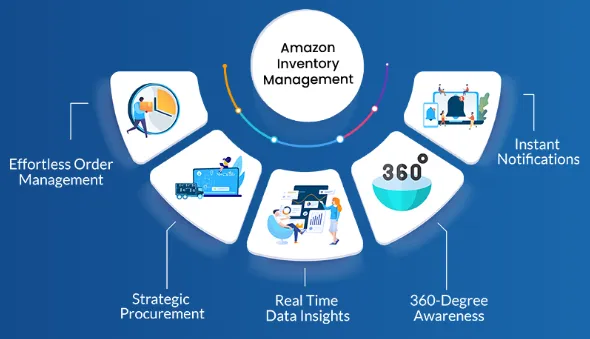Tips to Simplify Your Amazon Inventory Management Process

Tips to Simplify Your Amazon Inventory Management Process
Managing inventory effectively is one of the biggest challenges for Amazon sellers. Poor inventory management can lead to stockouts, overstocking, increased storage fees, and lost sales opportunities. A well-optimized inventory strategy ensures that you always have the right amount of stock available, reducing costs and maximizing profits. In this guide, we’ll share essential Amazon inventory management tips to help you streamline your operations and improve efficiency.
1. Utilize Amazon’s Inventory Management Tools
Amazon provides several tools to help sellers track and manage inventory more effectively. Amazon Seller Central includes features like Manage Inventory, Inventory Performance Dashboard, and Restock Recommendations that allow sellers to monitor stock levels and plan restocking efficiently. FBA sellers can also use the Inventory Age Report and Excess Inventory Report to make data-driven decisions on stock replenishment and liquidation.
2. Maintain an Optimal Stock Level
Keeping the right amount of inventory in stock is critical to avoiding both stockouts and overstocking. Running out of stock can hurt your Amazon Best Seller Rank (BSR) and lead to lost sales, while overstocking results in higher storage fees. To maintain optimal stock levels:
Monitor your sell-through rate to understand how quickly your inventory is selling.
Set reorder points based on historical sales data and seasonal demand.
Consider using Just-in-Time (JIT) inventory management to reduce storage costs.
3. Forecast Demand Accurately
Accurate demand forecasting helps you determine how much stock to order and when. Use historical sales data, market trends, and seasonality factors to make informed inventory decisions. Tools like Helium 10, Jungle Scout, and Amazon’s Demand Forecasting Reports can help predict future sales trends. Keeping an eye on competitor stock levels and pricing strategies can also provide valuable insights into upcoming demand fluctuations.
4. Leverage Amazon FBA for Streamlined Logistics
Fulfillment by Amazon (FBA) simplifies inventory management by handling storage, shipping, and customer service. However, FBA storage fees can add up if inventory isn’t managed properly. To optimize FBA inventory:
Regularly check Inventory Performance Index (IPI) scores to avoid excess storage fees.
Remove or discount slow-moving stock before long-term storage fees apply.
Use Amazon’s Multi-Channel Fulfillment (MCF) to sell inventory across multiple platforms while utilizing FBA’s logistics.
5. Implement an Automated Inventory Management System
Manual inventory tracking is time-consuming and prone to errors. An automated inventory management system helps sellers track stock levels in real time, generate reorder alerts, and sync inventory across multiple sales channels. Popular inventory management tools include:
SkuVault for warehouse and order management.
InventoryLab for FBA sellers who need cost and profitability tracking.
SoStocked for advanced forecasting and restocking automation.
6. Optimize Restocking Strategies
Efficient restocking prevents stockouts and keeps your listings active. Use the following strategies to ensure a smooth restocking process:
Replenishment Alerts: Set up alerts in Seller Central to receive notifications when stock levels drop below a certain threshold.
Supplier Communication: Build strong relationships with suppliers to reduce lead times and negotiate better terms.
Diversify Suppliers: Relying on a single supplier can lead to delays. Work with multiple suppliers to reduce risks and ensure a steady inventory flow.
7. Reduce Amazon Storage Fees with Inventory Turnover Optimization
Amazon charges monthly storage fees and long-term storage fees for inventory stored in FBA fulfillment centers. To avoid unnecessary costs:
Use Amazon’s liquidation programs to sell excess stock at a discounted rate.
Create promotions, deals, or bundle offers to move slow-moving inventory faster.
Remove inventory that hasn’t sold within 6–12 months to prevent long-term storage charges.
8. Monitor and Improve Inventory Performance Index (IPI) Score
Amazon’s Inventory Performance Index (IPI) score measures how efficiently you manage inventory. A higher IPI score ensures better inventory storage limits and lower fees. To maintain a good IPI score:
Reduce excess inventory and stranded inventory.
Improve sell-through rates by optimizing product listings and running PPC campaigns.
Restock inventory in a timely manner without overstocking.
9. Use Data Analytics for Smarter Inventory Decisions
Tracking key inventory metrics can help you make smarter decisions. Pay attention to:
Sell-through rate: The speed at which your inventory sells.
Inventory turnover ratio: The number of times inventory is sold and replaced in a given period.
Stockout rate: The frequency of running out of stock, which impacts sales and rankings.
Aging inventory report: Identifies slow-moving products that need clearance.
By analyzing these metrics, sellers can optimize their inventory strategy and improve profitability.
10. Plan for Seasonal Trends and Sales Events
Amazon experiences sales spikes during holidays, Prime Day, and Q4, requiring careful inventory planning. To prepare:
Increase stock levels for high-demand products well before peak seasons.
Run lightning deals and promotions to maximize sales potential.
Monitor competitor pricing and trends to stay competitive.
Final Thoughts
Effective Amazon inventory management ensures that you never run out of stock while avoiding costly overstocking and storage fees. By using Amazon’s built-in tools, automating processes, forecasting demand, and optimizing restocking strategies, sellers can improve inventory efficiency and boost profitability. Stay proactive, track key metrics, and continuously refine your approach to keep your Amazon business running smoothly. With the right inventory management strategy, you can increase sales, reduce costs, and grow your business successfully in 2025 and beyond.





